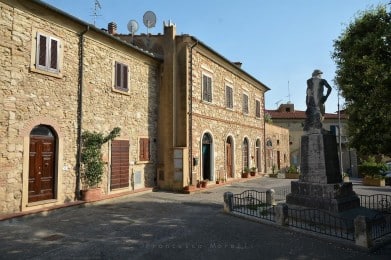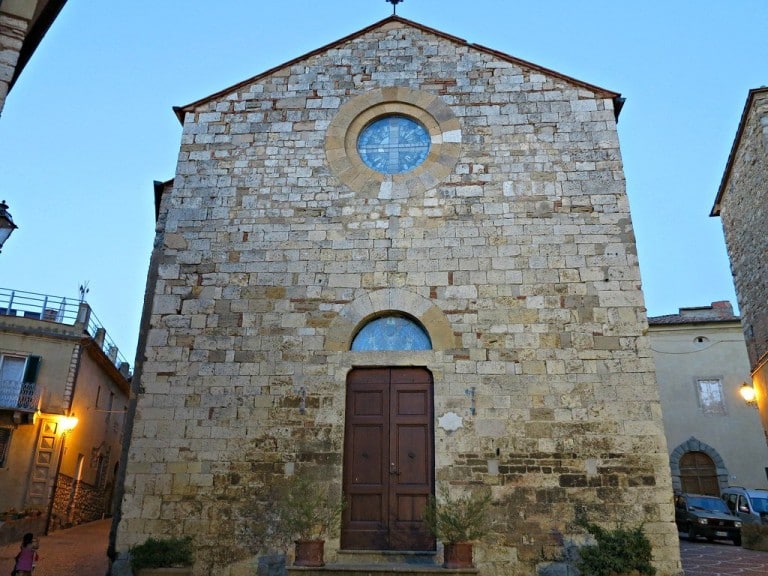In the ancient heart of the village of Bibbona, enclosed between the medieval wrinkles of the castle, stands the Pieve di Sant’Ilario, one of the most fascinating and mysterious Romanesque churches on the Etruscan Coast. Its history is intertwined with that of the village itself: already attested in 1154, it represents a staple of Bibbona’s religious and cultural life, testifying to the deep spirituality that permeated the area since the Middle Ages.
Architecture and transformations
The original structure of the church dates back to the Romanesque period and is partly preserved in the facade and right wall, while the addition of the left aisle, in late Gothic style, dates back to the 14th-15th centuries and gives the building an unusual trapezoidal shape, charged with symbolic meanings.
In the 16th century the church was officially elevated to a parish church, equipped with a baptismal font, and thus assumed a central role in the local religious community. Over the centuries, the Pieve di Sant’Ilario underwent numerous modifications, including the closing of the arches between the naves and the construction of a side door to access the Blessed Sacrament chapel. Only in the twentieth century, thanks to a thorough restoration, was it returned to its presumed original configuration: the arches were reopened, the plasters removed, and the interior returned to tell its thousand-year history.
Alleged Templar traces
What makes the parish even more fascinating is the alleged Templar presence, supported by some strongly suggestive symbolic elements. Engraved on either side of the portal and on the outer right wall are Templar crosses, one of which has arms ending in a trident (patte d’oie), a symbol associated with the French region of Languedoc and often associated with graffiti left by Templars in prisons and mansions beyond the Alps. It is speculated that, alongside the local clergy, a small contingent of monk-knights of French origin, linked to the Order of the Temple, operated in Bibbona.
The dedication to two saints, Hilary and Bartholomew, also reinforces the hypothesis of Templar symbolism, as it was the Order’s practice to name its religious buildings after key figures in the New Testament, often with reference to the duality of life-death, beginning-end.
The octagonal stoup: symbol of infinity and mystery
Inside the parish church is preserved a masterpiece of medieval symbolism: an octagonal stone holy water stoup. The octagon, a transitional figure between the square (earth) and the circle (sky), represents infinity and spiritual rebirth-a concept as dear to cathedral builders as to esoteric orders.
On the eight faces of the basin are found:
– Two lion protomes, symbols of strength and vigilance.
– One bearded and one hairless face, interpreted as representations of St. John the Evangelist (the end) and St. John the Baptist (the beginning), central figures in Templar worship.
-A five-petaled rose, a symbol of the summer solstice and linked to St. John the Baptist.
– A lion passant, emblem of the adversary whom the knight faces without weapons, as required by the Templar Rule.
– A Crucified Lamb, a figure of Christ, an emblem of sacrifice and redemption, contrasted with the strength of the lion.
– Finally, one face depicts a patente cross disguised as a wheel, a probable attempt to conceal a Templar symbol during historical phases of persecution.
An additional stoup, made of marble and dating from the 16th century, is located in the apse area of the church and is accompanied by a coeval ciborium made by local craftsmen. Completing the Pieve’s artistic heritage is a 16th-century canvas depicting Our Lady of the Rosary, kept inside.
A church that preserves time
To visit the Pieve di Sant’Ilario is to immerse oneself in a place charged with meaning, where art, religion, architecture and symbolism come together. It is not only a testimony of Tuscan Romanesque, but a crossroads of stories and legends, which refer to the Etruscans, the Templars, Leonardo and the sacred. In this space suspended between history and mystery, stone speaks, symbols guide and silence invites contemplation.
A “terrible place,” as the inscription on the portal of the nearby church of Santa Maria della Pietà reads, but only because it holds wonders that defy time and rationality.



